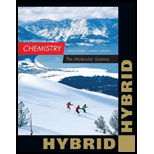
Concept explainers
(a)
Interpretation:
Conjugate partner for
Concept Introduction:
Brønsted-Lowry acid is the one which can donate
Difference between conjugate acid-base pair is
(a)
Explanation of Solution
Given formula is
Conjugate partner of
(b)
Interpretation:
Conjugate partner for
Concept Introduction:
Refer part (a).
(b)
Explanation of Solution
Given formula is
Conjugate partner of
(c)
Interpretation:
Conjugate partner for
Concept Introduction:
Refer part (a).
(c)
Explanation of Solution
Given formula is
Conjugate partner when
When this is added to water, a proton is transferred from acid to the water resulting in formation of
Conjugate partner of
Conjugate partner when
When this is added to water, a proton is transferred from water to the base resulting in formation of
Conjugate partner of
(d)
Interpretation:
Conjugate partner for
Concept Introduction:
Refer part (a).
(d)
Explanation of Solution
Given formula is
Conjugate partner of
(e)
Interpretation:
Conjugate partner for
Concept Introduction:
Refer part (a).
(e)
Explanation of Solution
Given formula is
Conjugate partner when
When this is added to water, a proton is transferred from acid to the water resulting in formation of
Conjugate partner of
Conjugate partner when
When this is added to water, a proton is transferred from water to the base resulting in formation of
Conjugate partner of
(f)
Interpretation:
Conjugate partner for
Concept Introduction:
Refer part (a).
(f)
Explanation of Solution
Given formula is
Conjugate partner of
Want to see more full solutions like this?
Chapter 14 Solutions
Chemistry: The Molecular Science, Hybrid Edition (with OWLv2 24-Months Printed Access Card)
- Write equations that show H2PO4- acting both as an acid and as a base.arrow_forwardThe weak base, CIO (hypochlorite ion), is used in the form of NaCIO as a disinfectant in swimming pools and water treatment plants. What are the concentrations of HCIO and OH and the pH of a 0.015 M solution of NaCIO?arrow_forwardUsing the diagrams shown in Problem 10-37, which of the four acids is the weakest acid?arrow_forward
- You are asked to determine whether an unknown white solid is acidic or basic. You also need to say whether the acid or base is weak or strong. You are given the molar mass of the solid and told that it is soluble in water. Describe an experiment that you can perform to obtain the desired characteristics of the white solid.arrow_forwardDifferentiate between the terms strength and concentration as they apply to acids and bases. When is HCl strong? Weak? Concentrated? Dilute? Answer the same questions for ammonia. Is the conjugate base of a weak acid a strong base?arrow_forwardWhich of the terms weak, strong, monoprotic, diprotic, and triprotic characterize(s) each of the following acids? More than one term may apply in a given situation. a. HC3H3O3 b. HCN c. H2SO4 d. H2SO3arrow_forward
- Which of the terms weak, strong, monoprotic, diprotic, and triprotic characterize(s) each of the following acids? More than one term may apply in a given situation. a. H3PO4 b. H3PO3 c. HBr d. HC2H3O2arrow_forward12.62 Write the formula of the conjugate acid of each of the following bases, (a) OH-, (b) NHj, (c) CHjNHt, (d) HPO/-, (e) CO.,2’arrow_forwardYou are asked to calculate the H+ concentration in a solution of NaOH(aq). Because sodium hydroxide is a base, can we say there is no H+. since having H+ would imply that the solution is acidic?arrow_forward
 Chemistry for Engineering StudentsChemistryISBN:9781337398909Author:Lawrence S. Brown, Tom HolmePublisher:Cengage Learning
Chemistry for Engineering StudentsChemistryISBN:9781337398909Author:Lawrence S. Brown, Tom HolmePublisher:Cengage Learning General, Organic, and Biological ChemistryChemistryISBN:9781285853918Author:H. Stephen StokerPublisher:Cengage Learning
General, Organic, and Biological ChemistryChemistryISBN:9781285853918Author:H. Stephen StokerPublisher:Cengage Learning Chemistry: The Molecular ScienceChemistryISBN:9781285199047Author:John W. Moore, Conrad L. StanitskiPublisher:Cengage Learning
Chemistry: The Molecular ScienceChemistryISBN:9781285199047Author:John W. Moore, Conrad L. StanitskiPublisher:Cengage Learning ChemistryChemistryISBN:9781305957404Author:Steven S. Zumdahl, Susan A. Zumdahl, Donald J. DeCostePublisher:Cengage Learning
ChemistryChemistryISBN:9781305957404Author:Steven S. Zumdahl, Susan A. Zumdahl, Donald J. DeCostePublisher:Cengage Learning
 Chemistry: An Atoms First ApproachChemistryISBN:9781305079243Author:Steven S. Zumdahl, Susan A. ZumdahlPublisher:Cengage Learning
Chemistry: An Atoms First ApproachChemistryISBN:9781305079243Author:Steven S. Zumdahl, Susan A. ZumdahlPublisher:Cengage Learning





